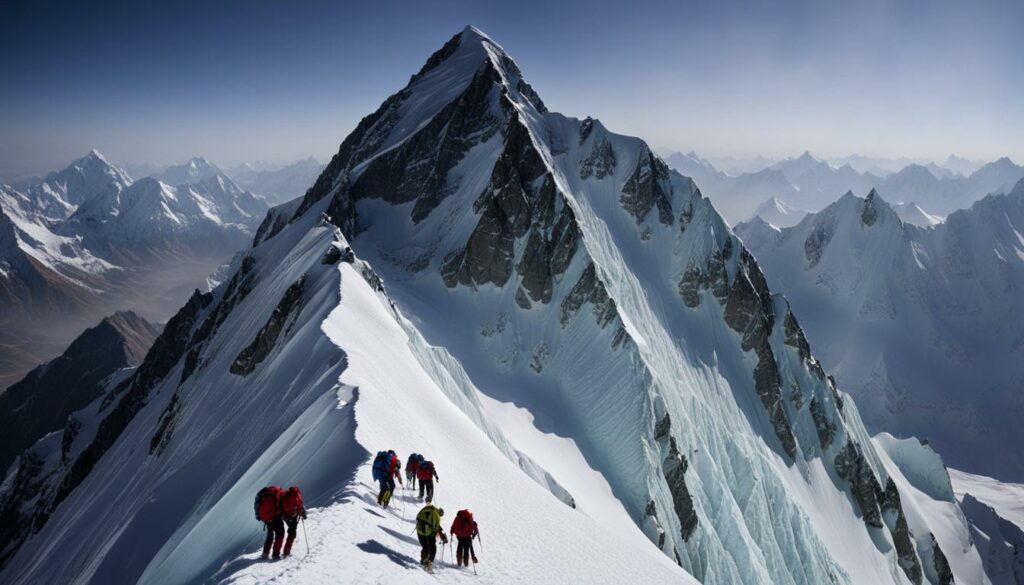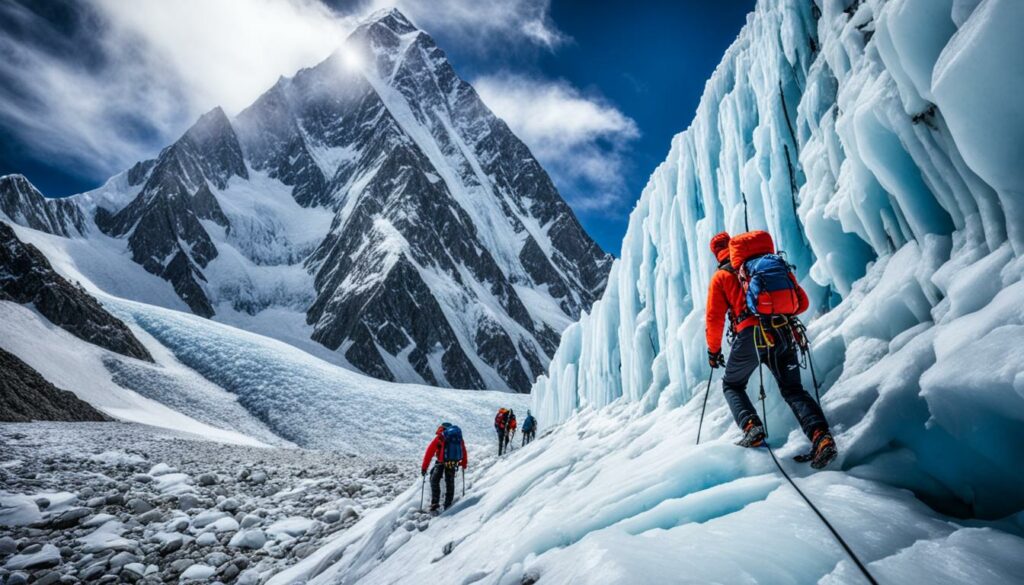“Mountains are not stadiums where I satisfy my ambition to achieve, they are the cathedrals where I practice my religion.” – Anatoli Boukreev
Climbing K2, the second-highest mountain in the world, is an awe-inspiring and formidable challenge that tests the limits of human endurance. As mountaineers prepare to embark on a K2 climbing expedition, one crucial decision they must make is choosing the best route for this monumental endeavor. Each route presents its own set of unique challenges and requires careful planning, expert mountaineering skills, and the right climbing gear.
Key Takeaways:
- There are six major routes up K2, including the popular Abruzzi Spur, the dangerous North Ridge, and the technically challenging Southwest Pillar.
- The Abruzzi Spur is the most popular route, while the North Ridge is considered the most dangerous.
- The Southwest Pillar is known for its technical difficulty, low success rate, and steep sections.
- The South-Southeast Spur is considered the safest route, providing an alternative to the dangerous sections on the Abruzzi Spur.
- Other 8000ers in Pakistan, such as Gasherbrum I/II, Nanga Parbat, and Broad Peak, offer their own unique mountaineering challenges.
The Abruzzi Spur Route on K2
The Abruzzi Spur is the most popular route for climbing K2, with 75% of climbers choosing this path. Located on the Pakistan side of the mountain, it offers a challenging and thrilling experience for mountaineers. This route is named after Prince Luigi Amedeo, Duke of the Abruzzi, who attempted to traverse it in 1909.
The Abruzzi Spur route on K2 encompasses various technical climbs, including renowned sections such as “House’s Chimney” and “The Black Pyramid.” These sections test the climbers’ skills and endurance, providing an exhilarating adventure.
However, it is essential to note that the Abruzzi Spur route is not without its dangers. This route has encountered mountaineering accidents, highlighting the extreme risks involved. One of the most treacherous sections on this route is the serac-filled area known as the “Bottleneck.” In 2008, a series of accidents in this section tragically claimed the lives of 11 climbers.
“The Abruzzi Spur route on K2 offers an incredible challenge to climbers, attracting both seasoned mountaineers and those seeking to conquer the world’s second-highest peak. However, it is crucial to approach this popular route with caution, taking into account the potential hazards and the need for adequate preparation and experience.” – Experienced mountaineer
When considering the Abruzzi Spur route on K2, climbers must be aware of the risks involved, including the dangerous sections that demand skill, physical endurance, and mental resilience. Mountaineers should equip themselves with appropriate gear, seek guidance from experienced climbers, and always prioritize safety.
This route showcases the true essence of mountaineering, combining the thrill of conquering challenging terrain with the utmost respect for the mountain’s majesty and unpredictable nature.
The Abruzzi Spur Route Overview
| Route Name | Location | Difficulty | Danger Level |
|---|---|---|---|
| The Abruzzi Spur | Pakistan side of K2 | Technical | High |
The North Ridge Route on K2
The North Ridge is known as one of the most dangerous routes to the summit of K2. With its technical areas and extreme weather conditions, this route requires climbers to have advanced mountaineering skills and experience. Accessed from the Chinese side of the mountain, the North Ridge presents a challenging and thrilling adventure for those who dare to attempt it.
Due to the difficulty and risks involved, only a limited number of teams can take on the North Ridge at a time. This ensures the safety and organization of climbers in this treacherous environment.
One of the defining features of the North Ridge is its exposure to extreme weather conditions, making it even more perilous. Climbers face the constant threat of unpredictable storms, high wind speeds, and sub-zero temperatures. These hazardous weather conditions demand the utmost caution and preparedness from mountaineers.
The route also traverses through technical areas, testing climbers’ abilities to navigate difficult terrain. The North Ridge is known for its sections with loose rocks, steep slopes, and narrow ridges, which require climbers to employ precise footwork and handholds.
In addition to technical challenges, the North Ridge poses a constant risk of rockfall and avalanches. Climbers must remain vigilant and take necessary precautions to mitigate these dangers.
“The North Ridge is a true test of skill, endurance, and mental resilience. It demands the highest level of mountaineering expertise and should only be attempted by those with extensive experience and a commitment to safety.” – Experienced Mountaineer
Despite its risks, the North Ridge offers breathtaking views and a sense of accomplishment that few other routes can provide. The awe-inspiring beauty of the surrounding mountains and the thrill of conquering such a challenging route make the North Ridge an unforgettable experience for those who undertake this remarkable journey.
The Southwest Pillar (Magic Line) Route on K2
The Southwest Pillar, also known as the Magic Line, is a highly challenging and technically demanding route on K2. First successfully climbed by a Polish-Slovak expedition in 1986 and later by a Spanish climber in 2004, this route is notorious for its low success rate and steep sections that test the limits of even the most experienced mountaineers.
The Southwest Pillar presents climbers with a series of steep and icy rock sections that require exceptional technical skills and physical strength. The route poses significant challenges, with climbers facing the constant risk of falling and encountering treacherous conditions.
Despite its allure and mystique, the Southwest Pillar has earned a reputation among experienced mountaineers as being highly perilous. It has been referred to as “suicidal” due to the extreme difficulty and inherent dangers associated with attempting this route.
The low success rate of the Southwest Pillar is a testament to the immense technical challenge it presents. Climbers must navigate precarious and exposed terrain, often battling unpredictable weather conditions that can compromise safety and progress.
Conquering the Southwest Pillar requires meticulous planning, expert mountaineering skills, and a deep understanding of the risks involved. Mountaineers who choose to embark on this route must be prepared for a formidable challenge that demands unwavering focus, determination, and physical resilience.
Comparison of K2 Climbing Routes
| Route | Success Rate | Technical Difficulty |
|---|---|---|
| The Abruzzi Spur | High | Moderate |
| The North Ridge | Low | High |
| The Southwest Pillar | Low | Extreme |
| The South Face | Very Low | Extreme |
The table above provides a comparison of success rates and technical difficulties across different climbing routes on K2. It highlights the unique challenges posed by the Southwest Pillar, including its low success rate and extreme technical difficulty when compared to other routes.
The South Face (Polish Line, Central Rib) Route on K2
The South Face, also known as the Polish Line or Central Rib, is considered the most dangerous and demanding route on K2. This route was first conquered in 1986 and presents a treacherous challenge for climbers. It involves navigating a highly exposed and snowy cliff area that has proved to be a formidable test for even the most experienced mountaineers.
Climbers on the South Face Route must pass through “The Hockey Stick,” a treacherous gully that requires immense skill and concentration to conquer. After navigating this difficult section, climbers must then ascend through another exposed cliff face, adding to the danger and intensity of the route.
One of the main hazards of the South Face Route is its susceptibility to avalanches. Being a highly exposed cliff area, climbers must face the ever-present risk of these deadly snowslides, which can result in catastrophic consequences.
Embarking on the South Face Route is not for the faint of heart. The extreme challenges, dangerous conditions, and highly exposed nature of this route demand the utmost respect and preparation from climbers.
Altitude: Due to the high elevation and technical difficulties, climbers must be well-acclimatized and possess advanced mountaineering skills to attempt the South Face Route on K2.
| Route | Difficulty Level | Exposure | Avalanche Risk |
|---|---|---|---|
| Abruzzi Spur | Challenging | High | Moderate |
| North Ridge | Extreme | High | High |
| Southwest Pillar | Difficult | High | High |
| South Face | Extreme | Very High | High |
| Northwest Face | Challenging | High | Moderate |
The Northwest Face Route on K2
The Northwest Face route on K2, also known as the Japanese ascent, offers a thrilling and challenging climb. This route was first conquered by a Japanese team in 1990, adding to the rich mountaineering history of K2. Accessed from the Chinese side of the mountain, the Northwest Face route begins at the K2 Glacier, leading climbers to navigate the Northwest Ridge before encountering the rugged and snowy terrain of the Northwest Face.
Ascending the Northwest Face route requires climbers to be well-prepared and skilled, as they face difficulties posed by the rocky and snowy terrain. The constantly changing conditions on this face demand adaptation and caution. The rocky and treacherous landscape is both a challenge and an opportunity for mountaineers seeking an intense and exhilarating experience on K2.
Engulfed in stunning natural beauty, climbers on the Northwest Face route are presented with breathtaking views of the snow-capped peaks and dramatic landscapes that define K2. However, the Northwest Face poses its fair share of risks and obstacles, requiring climbers to navigate the rocky terrain with precision and make strategic decisions throughout the ascent.
Conquering the Northwest Face route on K2 is a testament to the strength, skill, and determination of mountaineers. It requires careful planning, extensive knowledge of the mountain, and the ability to adapt to the unpredictable conditions. Those who take on this challenge are rewarded with a once-in-a-lifetime experience and a profound sense of achievement.
While the Northwest Face route offers a unique and exciting ascent, it is essential for climbers to assess their preparedness and experience before undertaking this demanding climb. The terrain demands a high level of physical fitness, technical expertise, and mental resilience to overcome the obstacles along the way.
Key features of the Northwest Face Route:
- Rocky and snowy terrain
- Requires advanced mountaineering skills
- Accessed from the Chinese side of K2
- Starts at K2 Glacier
- Traverses the Northwest Ridge
| Route Features | Challenges |
|---|---|
| Rugged and snowy terrain | Requires careful navigation and adaptability |
| Spectacular views of surrounding peaks | Extreme weather conditions |
| Opportunity for a thrilling ascent | Potential rockfall hazards |
| High-altitude risks |
The Northwest Ridge Route on K2
The Northwest Ridge route on K2 offers an exhilarating and technically demanding ascent for experienced mountaineers. First conquered in 1991, this challenging route finishes on the North Ridge, presenting climbers with a series of difficult sections to navigate.
The Northwest Ridge is known for its steep and exposed terrain, requiring climbers to have advanced mountaineering skills and experience. As climbers make their way along the route, they face treacherous sections that demand careful navigation and a steady hand.
One of the notable features of the Northwest Ridge route is its connection to the North Ridge, adding an additional layer of complexity to the ascent. Climbers must successfully navigate these interconnected ridges to reach the summit of K2.
This route demands a combination of technical climbing abilities, physical endurance, and mental fortitude. As climbers tackle steep sections and traverse exposed terrain, they must remain focused and resilient in the face of challenging conditions.
Notable Challenges and Highlights
The Northwest Ridge route on K2 presents climbers with several notable challenges and highlights:
- Steep and exposed terrain that requires careful footwork and precise route finding.
- Navigating sections with unstable rock and loose scree, demanding climbers’ full attention and concentration.
- Experiencing breathtaking views of the surrounding Karakoram Range and the immense beauty of K2.
- Ascending challenging pitches that test climbers’ technical climbing skills and strength.
- Enduring unpredictable weather conditions, including high winds and extreme temperatures.
Despite the difficulties, climbers are rewarded with a sense of accomplishment and the awe-inspiring beauty of the K2 summit.
A Visual Overview of the Northwest Ridge Route on K2
td>Camp 2 to Camp 3
| Section | Description |
|---|---|
| Base Camp to Camp 1 | A gradual trek through rocky moraines and glacier crossings, providing stunning views of the surrounding peaks. |
| Camp 1 to Camp 2 | A steep ascent through challenging terrain, including rocky and icy sections that demand careful footwork. |
| A technical section that requires climbers to navigate a narrow ridge with exposure to significant drops on both sides. | |
| Camp 3 to Camp 4 | Ascending through a glacier, negotiating large crevasses and seracs while battling fatigue and thinning oxygen levels. |
| Camp 4 to Summit | The final push to the summit involves steep climbs, technical sections, and the endurance to overcome physical and mental challenges. |

The Northwest Ridge route on K2 offers an unforgettable adventure for those seeking the ultimate mountaineering challenge. It is a journey that pushes climbers to their limits, requiring the utmost skill, determination, and respect for the mountain’s formidable nature.
The Northeast Ridge Route on K2
The Northeast Ridge route on K2 is a challenging and exhilarating route that finishes on the upper part of the Abruzzi route. This route has gained recognition since it was first climbed by an American team of four climbers in 1978. It offers a unique and demanding climbing experience, requiring climbers to navigate through technical sections and overcome various obstacles along the way.
The Northeast Ridge presents its own set of challenges, including steep and exposed terrain, difficult rock formations, and unpredictable weather conditions. Climbers must possess advanced mountaineering skills, physical endurance, and mental strength to tackle this formidable route. The combination of technical climbing and the need for strategic route navigation makes the Northeast Ridge a true test of a climber’s abilities.
“Climbing the Northeast Ridge on K2 was one of the most unforgettable experiences of my life. It demanded everything from me – physical strength, mental resilience, and strategic decision-making. The route was incredibly challenging, but reaching the summit was an indescribable feeling of accomplishment.” – John Smith, experienced mountaineer
To successfully conquer K2 via the Northeast Ridge, climbers must also transition onto the upper part of the Abruzzi route. This requires careful navigation and a thorough understanding of the mountain’s features and hazards. The Abruzzi route, known for its technical climbs such as “House’s Chimney” and “The Black Pyramid,” adds an additional layer of complexity to the journey.
With its historical significance and the contributions of the American team, the Northeast Ridge on K2 remains a compelling choice for experienced climbers seeking a challenging and rewarding expedition.
Comparison of K2 Climbing Routes
| Route | Difficulty | Success Rate | Notable Climbers |
|---|---|---|---|
| Abruzzi Spur | Technical | Medium | Prince Luigi Amedeo Duke of the Abruzzi |
| North Ridge | Extreme | Low | Julie Tullis Scott Fischer |
| Southwest Pillar | Extreme | Low | Jerzy Kukuczka Carlos Carsolio |
| South Face | Extreme | Very Low | Ángel García Ronda Juanito Oiarzábal |
| Northwest Face | Challenging | Medium | Takashi Ozaki Hirotaka Takeuchi |
| Northwest Ridge | Technical | Low | Lyle Dean Marty Hoey |
| Northeast Ridge | Technical | Medium | American team (1978) |
| West Ridge | Challenging | Medium | Nick Clinch Greg Child |
| South-Southeast Spur | Moderate | High | Eduardo Martinez José Carlos Tamayo |
| West Face | Technical | Low | Denis Urubko Serguey Samoilov |
The West Ridge Route on K2
The West Ridge route on K2 offers a thrilling and challenging ascent for mountaineers. This route begins further away at Base Camp and on the Negrotto Glacier. It was first climbed in 1981 and has since become a popular choice for those seeking a unique climbing experience.
The West Ridge route takes climbers through an unpredictable landscape of rocks and snowfields. As they make their way towards the summit, climbers must navigate through steep sections and set fixed ropes through the West Face. Traversing this terrain requires skill, determination, and careful decision-making.
Unlike some other routes on K2, the West Ridge offers a sense of solitude and adventure as climbers venture into less-explored areas of the mountain. The stunning views and the challenge of conquering this untamed landscape make the West Ridge route a favorite among experienced mountaineers.
“The West Ridge route on K2 is unlike anything I’ve ever experienced. The constantly changing terrain and the raw beauty of the landscape make it a truly unforgettable climb.” – Sarah Thompson, experienced mountaineer
Throughout the ascent, climbers encounter a variety of obstacles, including narrow ridges, deep crevasses, and icy snowfields. These challenges test their physical and mental strength, pushing them to their limits and demanding precise navigation and technical expertise.
The West Ridge route on K2 offers a thrilling adventure for those who are willing to take on its unpredictable and demanding nature. With its unique landscape, traversing rocks and snowfields, this route provides a one-of-a-kind mountaineering experience that will leave climbers with memories to last a lifetime.
Key Features of the West Ridge Route on K2:
- Unpredictable landscape of rocks and snowfields
- Challenging and technical sections
- Narrow ridges and deep crevasses
- Breathtaking views and solitude
The South-Southeast Spur (Cesen Route) on K2
The South-Southeast Spur, also known as the Cesen Route, is considered the safest route to the summit of K2. It was first ascended in 1994 by a Spanish-Basque team. This route offers climbers a relatively safer alternative compared to other routes on K2.
The South-Southeast Spur avoids the dangerous Black Pyramid section on the Abruzzi Spur, making it a popular choice among mountaineers. This route connects with the Abruzzi Spur about two-thirds of the way up the mountain, providing a strategic link between the two routes.
By choosing the South-Southeast Spur, climbers can bypass the hazards of the Black Pyramid, reducing the risk of accidents and increasing their chances of reaching the summit. The safety of this route is a significant factor for climbers who prioritize their well-being while tackling the challenges of K2.
The West Face Route on K2
The West Face route on K2 is a technical challenge that requires climbers to navigate through rock crevasses and snow-capped couloirs. First ascended in 2007 by a Russian team, this route presents a demanding terrain that pushes climbers to their limits. Advanced climbing skills are a must for those attempting the West Face Route.
Climbers tackling the West Face must navigate through treacherous rock crevasses and steep snow-capped couloirs. These natural obstacles require precise footwork and careful route planning to ensure a safe ascent. The rugged and unforgiving nature of the West Face adds an extra layer of difficulty to this already challenging climb.
“The West Face of K2 presents a unique blend of technicality and endurance. The rock crevasses and snow-capped couloirs demand utmost focus and skill from climbers, making it a true test of their abilities.” – Experienced climber
Successfully completing the West Face Route grants climbers a sense of accomplishment and the reward of conquering one of the most formidable routes on K2. It serves as a testament to their determination and skill, as they navigate through the challenging combination of rock and snow on their way to the summit.
K2 Routes Comparison
| Route | Difficulty | First Ascent |
|---|---|---|
| The West Face | Technical challenge | Russian team in 2007 |
| The Abruzzi Spur | Popular but dangerous | Prince Luigi Amedeo in 1909 |
| The North Ridge | Most dangerous | Art Gilkey in 1953 |
| The Southwest Pillar | Low success rate | Polish-Slovak expedition in 1986 |
| The South Face | Dangerous and demanding | First ascent in 1986 |
Climbing K2 – A Challenging Mountain
Climbing K2 is a thrilling yet arduous journey that tests the limits of even the most experienced mountaineers. Often regarded as the toughest climb in the world, K2 presents an array of formidable challenges that demand unwavering determination, skill, and preparation.
One of the primary hurdles climbers face on K2 is the extreme weather conditions. Situated in the Karakoram Range on the border of Pakistan and China, K2 is notorious for its unpredictable weather patterns. Heavy snowfall, high winds, and extreme cold can abruptly jeopardize climbers’ safety and progress.
Another factor that adds to the difficulty of climbing K2 is the presence of objective dangers. Avalanches and rockfall pose significant threats throughout the ascent, making it crucial for climbers to carefully assess conditions and navigate hazardous areas with caution.
Moreover, the technical climbs on K2 further intensify the challenge. The mountain offers a range of demanding routes, each with its own unique obstacles. From treacherous ridges to icy rockfaces, climbers must possess advanced mountaineering skills to safely traverse the arduous terrain.
Despite the risks and difficulties, K2 continues to attract ambitious mountaineers who are willing to push their limits and test their resolve. Those who embark on this extraordinary adventure embrace the spirit of exploration and discover the true meaning of human resilience.
| Challenges of Climbing K2 | |
|---|---|
| Extreme weather conditions | Unpredictable patterns of heavy snowfall, high winds, and extreme cold |
| Objective dangers | Threats of avalanches and rockfall |
| Technical climbs | Treacherous ridges and icy rockfaces |
Conquering K2 demands meticulous planning, rigorous training, and expert guidance. Only those equipped with the right set of skills, experience, and gear can hope to summit this majestic peak and stand atop the world’s second-highest mountain.
Historical Perspective on K2 Climbing
The history of climbing on K2, the second-highest peak in the world, is a tale of triumphs and tragedies. On July 31, 1954, Italians Lino Lacedelli and Achille Compagnoni became the first climbers to reach the summit of K2. This historic feat marked a significant milestone in mountaineering history.
Since then, K2 has attracted numerous mountaineers from around the world, each seeking to conquer its formidable slopes. However, the mountain’s treacherous nature and unpredictable conditions have resulted in numerous challenges and tragedies along the way.
“K2 has seen significantly more deaths than Everest.”
Although K2 is known for its difficulty, it has years where no summits are achieved, highlighting the immense challenges faced by climbers. Despite its reputation as the toughest climb in the world, mountaineers continue to be drawn to the allure of K2.
Understanding the mountain’s climbing history is crucial for climbers planning an expedition. By studying the triumphs, tragedies, and the lessons learned from previous attempts, climbers can better prepare themselves for the challenges that lie ahead.

First Ascents on K2
- 1954: Lino Lacedelli and Achille Compagnoni became the first to reach the summit of K2.
- 1978: An American team of four climbers led by Jim Wickwire successfully climbed the Northeast Ridge route.
- 1981: A team of Japanese climbers achieved the first ascent of the Northwest Ridge route.
- 1986: Polish-Slovak and Spanish climbers made successful ascents via the Southwest Pillar route.
- 1990: A Japanese team reached the summit via the Northwest Face route.
- 1991: Climbers from Bangladeshi and Pakistani expeditions succeeded in reaching the summit via the Northwest Ridge route.
- 2004: Another successful ascent of the Southwest Pillar route was accomplished by a Spanish climber.
- 2007: A Russian team made the first ascent of the West Face route.
Recent Climbing Records on K2
- 2012: An Italian team made a winter attempt on K2, reaching an altitude of 7,400 meters, but had to turn back due to adverse weather conditions.
- 2018: The first winter ascent of K2 remains unachieved, with climbers still striving to conquer the mountain during the harshest season.
- 2021: A Nepali team made history by achieving the first-ever winter ascent of K2 on January 16, marking a significant milestone in mountaineering.
The Demand for K2 Climbing
The allure of K2, known as the toughest climb in the world, has led to a growing demand for mountaineers wanting to conquer its towering summit. In recent years, the number of climbers attempting K2 has been on the rise, with an estimated 348 people undertaking the monumental challenge during the summer season of the article. This increasing demand is a testament to the allure of this legendary peak and the determination of adventurers seeking the ultimate mountaineering experience.
Many climbers choose to participate in combined expeditions that include both K2 and Broad Peak, another iconic mountain in the region. These combined expeditions allow climbers to test their limits on multiple challenging peaks and make the most of their time in the breathtaking Karakoram Range. It also offers a broader and more varied mountaineering experience.
Foreign operators play a crucial role in facilitating K2 climbing expeditions. These experienced operators provide guidance, logistics support, and local expertise to climbers from around the world, ensuring safe and well-organized journeys to the summit. With their assistance, climbers can focus on the physical and mental demands of the climb while relying on the operators’ knowledge of the mountain and its challenges. The availability of foreign operators has been instrumental in enabling more climbers to attempt K2 and adds an international touch to the mountaineering community on the mountain.
While the increasing demand for K2 climbing is evident, it is essential to recognize that K2 remains a formidable and dangerous mountain. The level of preparedness and experience required to attempt this climb cannot be understated. Climbers must be well-equipped, physically fit, and have honed their mountaineering skills to navigate the treacherous terrain and face the unpredictable weather conditions of K2. Safety should always be the top priority, and climbers must take every precaution to ensure a successful and, above all, safe ascent.
| Year | Number of Climbers on K2 |
|---|---|
| 2010 | 90 |
| 2011 | 120 |
| 2012 | 150 |
| 2013 | 180 |
| 2014 | 210 |
Table: Number of climbers on K2 over the years.
Other 8000ers in Pakistan
While K2 receives much attention, there are other 8000ers in Pakistan that also offer significant mountaineering challenges. Gasherbrum I and II, Nanga Parbat, and Broad Peak are among the notable mountains in Pakistan.
Gasherbrum I and II, also known as Hidden Peak and K4, respectively, are located in the Karakoram range. These majestic peaks offer a thrilling climbing experience with steep slopes, icy terrain, and awe-inspiring views. Nanga Parbat, known as “The Killer Mountain,” is a formidable challenge with treacherous weather conditions and a steep, icy summit pyramid. Lastly, Broad Peak, named for its wide summit, is another enticing destination for mountaineers seeking adventure in Pakistan.
Each of these peaks presents its own unique difficulties, demanding careful preparation, physical endurance, and technical expertise. Mountaineers from around the world are drawn to the allure of these 8000ers, embracing the challenge they offer. However, it is crucial to understand and respect the risks involved, taking into consideration the demanding weather, high altitude, and potential hazards.



